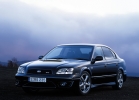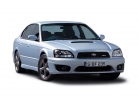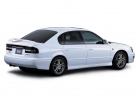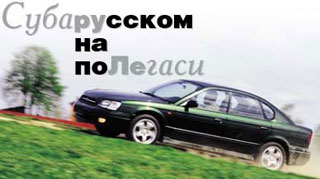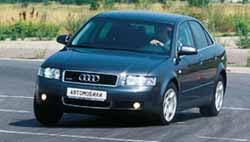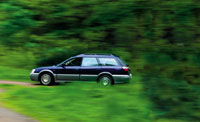Subaru Legacy test drive 1999 - 2002 sedan
I'm not fat, I'm full!
 Even a child will go on a three -wheeled bike. Adult boys ride on two wheels, and aunts in the circus - already on one wheel. Why then make all -wheel drive sedans?
Even a child will go on a three -wheeled bike. Adult boys ride on two wheels, and aunts in the circus - already on one wheel. Why then make all -wheel drive sedans? During puberty, they are measured, who writes above the wall. Having gained life experience and making sure that, regardless of the result, spray is equally flying on competing, move to higher matters. For example, who drives a car better. Every dispute inevitably flows into the discussion about which drive is better - front or rear. And only a few owners of all -wheel drive sedans listen to these disputes with a condescending smile. They know for sure that the best drive is front and rear at the same time.
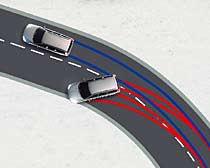 Step over the line. And seriously, all -wheel drive cars went into everyday life from racing catwalks. In real life, they can only interest those who really love to ride. More precisely, who operates their car, regardless of the year: rain, snow, dirt or ice. On dry asphalt and at the average temperament of the driver, all -wheel drive is not needed. Such a driver simply will not feel it.
Step over the line. And seriously, all -wheel drive cars went into everyday life from racing catwalks. In real life, they can only interest those who really love to ride. More precisely, who operates their car, regardless of the year: rain, snow, dirt or ice. On dry asphalt and at the average temperament of the driver, all -wheel drive is not needed. Such a driver simply will not feel it. Manufacturers of all -wheel drive options for popular sedans and station wagons do not expect that their owners will use Mercedes 4Matic or Golf 4Motion as a jeep on a broken country. The maximum that the owner of an all-wheel drive sedan can count on, and this is his difference in patency and ordinary mortals is increased chances of getting out of the snowy yard in the morning or calmly get to the summer cottage on the autumn-spring soil thaw.
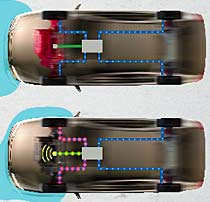 The designers installed all -wheel drive on cars so that their owners feel much more confident in difficult road conditions - on a snowy road, in the mountains, on wet asphalt. Even a novice driver knows how to break the car’s breakdown in a skid, for example, when passing a steep turn.
The designers installed all -wheel drive on cars so that their owners feel much more confident in difficult road conditions - on a snowy road, in the mountains, on wet asphalt. Even a novice driver knows how to break the car’s breakdown in a skid, for example, when passing a steep turn. The rear axis of the car constantly seeks to slip out of turn - if this process is not controlled, then the car begins to rotate around its axis. It is known that there are some rules for the withdrawal of a car from a drift that are specific to the front and rear -wheel drive, but statistics also indicate that quite often people fall in an accident, transplanting from the classics to front -wheel drive and vice versa.
Full -wheel drive cars are much more democratic in their behavior and often allow their owner to cross the face of what is permitted a little: rush along the road on the verge of a foul. The limits of the permissible speed when passing turns are much higher. So all -wheel drive is still speed and adrenaline.
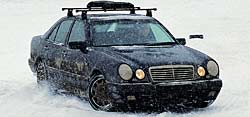 Fee for risk. Do not flatter yourself with the presence of 4x4 or 4WDs on such cars, remember once and for all - these are not SUVs. As a rule, a handout with a decrease nearby is not installed on all -wheel drive sedans. These are still cars for public roads, but they are usually more expensive than their single -wheel drive counterparts.
Fee for risk. Do not flatter yourself with the presence of 4x4 or 4WDs on such cars, remember once and for all - these are not SUVs. As a rule, a handout with a decrease nearby is not installed on all -wheel drive sedans. These are still cars for public roads, but they are usually more expensive than their single -wheel drive counterparts. We have chosen three business class sedans for our test. Mercedes E-Klasse 280 4Matic (the difference in price with the usual eye is about $ 4.5 thousand), Audi A6 2.4 Quattro (difference-$ 4 thousand) and Subaru Legacy 2.5. Cars are different in price, but similar in principle and ideology.
The choice is quite subjective - sedans, hatchbacks and station wagons at all -wheel drive transmission are made by many companies. These are mainly universals (Volvo, VW, Mitsubishi), but they, as a rule, differ from simple versions with a higher clearance.
There are also emphasized sports cars - VW Golf and Bora, Subaru Impreza, on the approach of Volvo S60. In such cars, all -wheel drive is a tribute to sports fashion. But the principle laid down in their design does not change - it will be discussed.
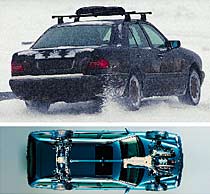 Good gelding. The Mercedes all-wheel drive system is primarily affected by the philosophy of the company-the classic Mercedes Sedan should be rear-wheel drive. Therefore, the torque is distributed between the front and rear wheels in a ratio of 35:65 percent. This ratio is constantly and never changes. The distribution of the engine effort is carried out through a mechanical handout, which is integrated into the end of the gearbox.
Good gelding. The Mercedes all-wheel drive system is primarily affected by the philosophy of the company-the classic Mercedes Sedan should be rear-wheel drive. Therefore, the torque is distributed between the front and rear wheels in a ratio of 35:65 percent. This ratio is constantly and never changes. The distribution of the engine effort is carried out through a mechanical handout, which is integrated into the end of the gearbox. 4Matic quite successfully drags a car along a bad road, despite the fact that all three differentials are not equipped with locks. Mercedes, as usual, went in his own way, forcing the ETS all -wheel drive (electronic clutch control with the road). Maybe it is correct - the installation of ETS, as part of the standard brake system, is inexpensive, while it is compact and reliable.
The principle of work ETS is this: if one of the wheels begins to slip, that is, loses its adhesion to the road, then it immediately slows down. Accordingly, the power of the torque is thrown to another wheel that the car is still dragging. If the front or rear wheels are completely slipped, then they still slow down. The force through the center differential will be transferred, respectively, or forward, but still in the ratio of 35:65. A forced shutdown of the ETS system is not provided - it will automatically remove its control over the front wheels at speeds over 80 km/h and the rear - over 120 km/h.
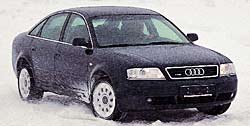 The furrow does not spoil. Our test drive showed that Mercedes 4matic turned out to be the most incomplete among his distant relatives. In the sense that his behavior is too reminiscent of the manners of the classic rear -wheel drive sedan. At a sharp start from a place on a snowy surface, the rear wheels work for some time with a slip - the front is too little effort to immediately start dragging the car forward. But at the beginning of the acceleration, there is no one characteristic of the rear -wheel drive backward in jazz only a girl - even 35 front interest is enough to maintain a given term stability.
The furrow does not spoil. Our test drive showed that Mercedes 4matic turned out to be the most incomplete among his distant relatives. In the sense that his behavior is too reminiscent of the manners of the classic rear -wheel drive sedan. At a sharp start from a place on a snowy surface, the rear wheels work for some time with a slip - the front is too little effort to immediately start dragging the car forward. But at the beginning of the acceleration, there is no one characteristic of the rear -wheel drive backward in jazz only a girl - even 35 front interest is enough to maintain a given term stability. In turns, in an empty Khodynsky field, the presence of an ESP system (a course stability system) begins to irritate. She instantly strangles the engine if the car is at least a little in the skid.
As a result, we were convinced that the all -wheel drive system on Mercedes was created exclusively to increase control safety. It never occurred to the car with a three-beam star on the hood even a shade of off-road qualities by Daimler-Benz.
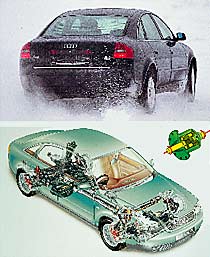 Popular mechanics. Audi A6 all -wheel drive is built on a different principle - no electronics, pure mechanics. The basis of the QUATTRO system is the self -locking differential Torsen. In the late 50s, he was invented by engineer Glesman. The name is an abbreviation of two English words Torque and Sensing, which can freely translate as catching the moment. Because Torsen works something like this. At rest, on dry even asphalt, the force from the engine is transmitted to the front and rear axles in a ratio of 50:50. And when the wheels slippage, the differential begins to drive the craving between the axes within 25 by 75 percent. That is, depending on the conditions, the A6 is periodically more in front, then more rear-wheel drive.
Popular mechanics. Audi A6 all -wheel drive is built on a different principle - no electronics, pure mechanics. The basis of the QUATTRO system is the self -locking differential Torsen. In the late 50s, he was invented by engineer Glesman. The name is an abbreviation of two English words Torque and Sensing, which can freely translate as catching the moment. Because Torsen works something like this. At rest, on dry even asphalt, the force from the engine is transmitted to the front and rear axles in a ratio of 50:50. And when the wheels slippage, the differential begins to drive the craving between the axes within 25 by 75 percent. That is, depending on the conditions, the A6 is periodically more in front, then more rear-wheel drive. It is quite difficult to describe the work of such a mechanism. We will try to explain on the fingers how these hedgehogs copulate. The differential is integrated into the gearbox and is a closed case, from which two shafts emerge, roughly speaking, on the front and rear axles. Both shafts are in a rigid engagement.
The Torsen differential does not monitor the rotation of the wheels, but their clutch with the road in the contact spots, as experts say. That is, it reacts to the effort, the necessary wheels at the moment in order to rotate and push/pull the car in the right direction normally. The redistribution of the force from the motor occurs at the right time almost instantly, in accordance with road conditions.
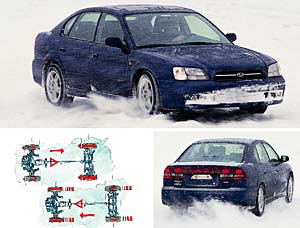 Sit and lead. The Audi A6 with a 2.4 -liter engine and a mechanical gear motor visited our test. By the way, in this case, it does not matter that Mercedes and Subaru were equipped with machine guns. According to the autopilot, the purity of the experiment was fully observed. Firstly, Mercedes 4Matic is produced almost only with automatic transmission in connection with an orientation to the American market. Subaru, which will be discussed below, can be purchased with a manual box, but it is precisely the machine guns that are in demand. Secondly, in all three cars, all-wheel drive in any mode works as if on its own, without requiring unnecessary body movements from the driver.
Sit and lead. The Audi A6 with a 2.4 -liter engine and a mechanical gear motor visited our test. By the way, in this case, it does not matter that Mercedes and Subaru were equipped with machine guns. According to the autopilot, the purity of the experiment was fully observed. Firstly, Mercedes 4Matic is produced almost only with automatic transmission in connection with an orientation to the American market. Subaru, which will be discussed below, can be purchased with a manual box, but it is precisely the machine guns that are in demand. Secondly, in all three cars, all-wheel drive in any mode works as if on its own, without requiring unnecessary body movements from the driver. So, Audi A6 Quattro. The most balanced device, completely devoid of prejudices of the front or rear -wheel drive. The only one who was on simple highway and at the same time did not shame the QUATTRO nameplate. At a sharp start from the place, he confidently rushed into the snow distance, without even trying to go astray from the course intended by the driver. When one or even two wheels fell on the ice baldness, it was enough just to correctly adjust the direction of movement with the steering wheel - not the slightest desire to break into the skid!
In its behavior, this is the most predicted car from the entire trinity: he simply and without hesitation goes to where his owner wants.
CHAMELEON. The Subaru brand in life is associated with people with all -wheel drive. And few people think that the company's engineers put a completely different principle than Mercedes or Audi. The hard distribution of torque between the axes in Subaru is opposed to a system that automatically adapts to road conditions.
At our disposal was a Legacy sedan with an automatic transmission. In a normal road situation, on dry asphalt, 90 percent of the torque is transmitted to the front wheels. In case of slipping them, there is a redistribution of the moment to a ratio of 50:50.
This is possible thanks to the use of a special coupling in a gearbox that works on the principle of conventional adhesion. Only in it is not one disk, but a lot. And friction, destructive for any clutch, goes for the good. On all Legacy wheels, special sensors are fixed, which monitor the speed of rotation of the axes of the car. As soon as it increases - that is, at the time of active slipping, the sensor sends a signal to a hydraulic drive that begins to press the couples of the coupling, smoothly increasing the adhesion of the disks among themselves. Part of the traction force is selected from the front axle and directed to the rear wheels.
In cars with a mechanical gearbox, the role of hydromoft is played by Wylian Its difference lies in the absence of hydraulic drives. The discs simply rotate in a special liquid, which with an increase in friction (at the time of slipping) begins to actively thicken. The clutch of disks increases, and the traction force is redistributed in favor of those wheels that have the best adhesion to the road. The system is reliable, tested by time, but works with a little delay, in contrast to the hydromechanical coupling. The Legacy automatic transmission also provides position L, meaning a lower gear. When it is turned on, the traction force transmitted from the motor to the wheels increases by about one and a half times. In models with a mechanical box, manual switching to a reduced gear is provided.
Bange of TRP. With his low, relatively two competitors, the cost of Subaru Legacy turned out to be the most passable of all the rods and pleased us with a real sports character. Yes, at a sharp start from a place on the asphalt covered with ice porridge, his behavior in the first second is frankly front -wheel drive. The starting trajectory has to be slightly adjusted by the steering wheel. But in races along the snow -covered Khodynsky field, this feeling completely disappears. Moreover, throwing this car at the request of the photographer in the skid was not so simple the first time. Legacy agreed to demonstrate an active skid only with the simultaneous work by the steering wheel and at the same time gas-car-gaz. Real sports character.
So, on the sedane all -wheel drive you should not conquer the virgin lands. Full -wheel drive on cars is more complex, and therefore more expensive to maintain and repair. Thirdly, all-wheel drive is an ideal option for an ambitious driver who wants to have a business class car, but not depend on the vagaries of urban weather and enjoy driving every day.
Text Nikolay Sukhov, photo Alexey Ilyin
Source: "Autopilot"
Video Crash tests Subaru Legacy 1999 - 2002
Subaru Legacy test drives 1999 - 2002
Crash Test Subaru Legacy 1999 - 2002
Krassh Test: Detailed Information27%
Driver and passengers
5%
Pedestrians



